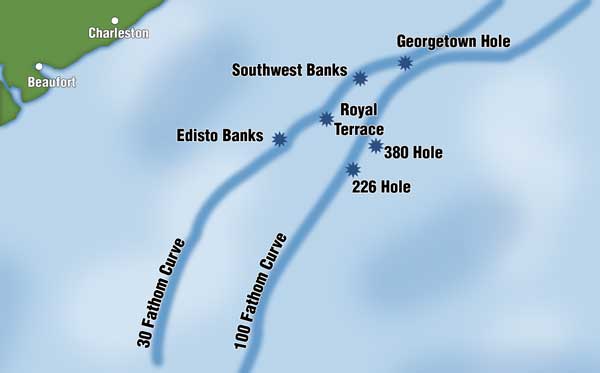
Eager dolphin are the mainstay of the ultra-productive offshore fishery out of Charleston.
Finally, it’s the time that bluewater fishermen have been waiting for, to reaquaint themselves with the sound of a screaming reel.When dawn cracks in the eastern sky, anglers hope to see flying fish scurrying out of the boat’s wake. The color change from bright green to azure blue signals the beginning of the Gulf stream and the time to start fishing for dolphin.
After a nearly 3-hour ride out from Charleston, the charterboat Aggressor slows and comes off plane, and Capt. Michael Runey says, “Let’s catch some fish.”
It was an early wake-up call to be sure, leaving Shem Creek at 3:30 a.m., but being on the fishing grounds for the daylight bite is a powerful motivator. A 60-foot B&B sportfisher that was built in April 2008 in Manteo, N.C., Aggressor is powered by twin 1,700 HP diesels. Being capable of of making 27 knots through sloppy seas and total darkness helps when your destination is 60 miles away, at the “Georgetown Hole.”
Before most folks had stirred from the cabin, mate Will Thornhill had the first baits in the water, and it didn’t take long for the first strike. Michael Johnson of Orangeburg was first up, and he boated a fine dolphin.
When winds are light and favorable, the ocean can be flat calm or hold a gentle 2- to 3-foot swell. Thornhill said a friendly ocean for fishing is “not too still and not too rough.” The best trolling speed is five knots, and Runey keeps a sharp eye for bait, diving birds, weedlines and temperature changes, all critical for finding concentrations of fish.
The Georgetown Hole is about four miles across and has variations in depth from 150 to 600 feet in the space of a few hundred yards.
“The Gulf stream current that runs over this formation creates many varied upwellings that carry baitfish nearer the ocean’s surface,” Runey said. “When baitfish become elevated in the water column, it often causes gamefish to strike.”
Aggressor’s stout rods and heavy-duty reels are rigged with 8/0 Mustad hooks, a half-ounce lead sinker and Sea Witch skirts. Ballyhoo from south Florida is the preferred bait. With three or four lines deployed off the bridge and six lines fished from the cockpit, it creates something resembling a spider web of monofilament needed to attract the ocean’s tough-fighting dolphin.
The bait spread paid off with a doubleheader, creating plenty of excitement. Runey yelled from the cockpit, “We’re in a school of them!” Thornhill and John McElroy raced to reel in the extra lines to avoid tangles with the two lines that were hooked-up. Both fish were boated after coming to the transom simultaneously, each one gaffed cleanly and added to the fish box.
A hooked dolphin can be seen easily in the clear water, and they jump a lot making for increased angler excitement.
Runey has captained sport fishing vessels in Venezuela, St. Thomas, the Dominican Republic, Mexico and the Bahamas, and he knows dolphin traits and habits, sharing that dolphin eat almost 20 percent of their weight a day, and that they have very good eyesight —which is why daisy-chain squid, with a ballyhoo coming up from behind, always seem to get a lot of attention.
The ocean is truly full of dolphin, and bag limits — 10 per person per day, or 60 per boat per day — reflect that. Some dolphin are bright green and yellow, others are a pale shade of the same colors dotted with bright blue flecks, and silver and blue colorations are not unusual.
Once Runey finds fish, he stays in the same area until the school breaks up, because dolphins keep coming back again and again when they are “in the bite” and excited.
“A key is to have your gear organized, with lots of extra tackle, so you don’t miss out on a bite,” said Runey, who fishes ballyhoo with blue, white or crystal skirts. “We keep an additional three of four rods and reels rigged with ballyhoo to use as pitch-baits when the dolphin action is frantic.”
The key to finding dolphin, Runey said, is to find things that “don’t belong” on the ocean’s surface. That can be anything from a 50-foot-wide weedline to a 5-gallon bucket — Runey caught 60 dolphin hanging around just such a bucket one day. Dolphin love to eat flying fish, crabs, sargasum and other dolphin, so cutting into the first dolphin you bring aboard and checking its stomach contents can bring great advantage.
If you find glass minnows in the belly of a dolphin, you know they are feeding on small baits. While a grown Spanish mackerel can make a great dolphin bait, it sometimes can also attract the attention of barracuda. Small baits work fine; as Runey said, “Hey, after all, elephants eat peanuts.”
On slow days, Runey will often stop next to a weedline and toss out chunks of ballyhoo or squid to try and attract dolphin. He also saves and freezes the “tired” ballyhoo at the end of each day so he’ll have good chum without having to cut up fresh ballyhoo. He stops, drops his chum and baits, and waits about 15 minutes before moving to another spot on the weedline to repeat the tactic.
Richard Coen of Mount Pleasant, who owns Aggressor, likes to change the bait spread once he’s caught plenty of dolphin, adding a diving planer to the spread. Runey said a planer can often jump start dolphin action on days when the ocean seems to hold no fish. He likes to troll along a weedline with a planer down deep, and while this method requires a lot of cleaning off the line and lure along the way, Runey says it is worth the effort.
Coen shares his exuberance for offshore fishing with everyone on board. He takes to fishing like Spanish moss takes to an oak tree — he’s all over it. He knows that good ballyhoo can sometimes make the difference with finicky dolphin.
“You gotta have good bait if you’re going to take the time to run offshore and fish for dolphin. Besides, in the big picture of fuel costs and maintenance, bait is cheap,” he said.
Aggressor does a lot of conservation work, working with the S.C. Department of Natural Resources through its cooperating angler program. Many “peanut” dolphin are tagged and released, allowing fisheries scientists to accumulate data on dolphin migration. In 2007, the boat tagged and released 300 dolphin, John Geddings of the SCDNR is a frequent visitor. They have successfully satellite-tagged and released blue marlin when opportunity knocked.
With plenty of dolphin in the fish box, it was almost time to pull the lines and head back to the real world to clean fish. At 3 p.m., however, a sailfish rose near the teaser and inhaled a ballyhoo. Thornhill screamed that he’d seen another sailfish, and on cue, another reel started screaming. With rods being cleared and passed around, a third reel started clicking, and Runey declares a triple-header on sailfish.
But in the next instant, one was no longer hooked-up, and another was freed as the line parted. But in the fighting chair, Jeff Baumann of Huger boated his first-ever sailfish in short order, with everyone on the boat witnessing how anything can happen in the bluewater.
The wild-card of a billfish strike is hard to resist, but gamefish like the dolphin are generally the “main course” for offshore trips out of South Carolina.


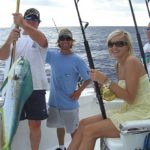
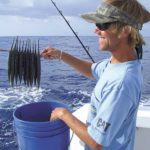
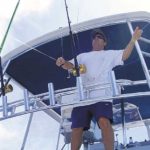
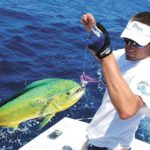


Be the first to comment